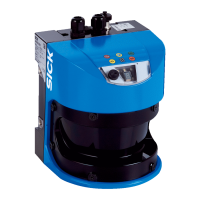8013796/UL20/2010-09-27 © SICK AG · Division Auto Ident · Germany · Subject to change without notice 7
Operating Instructions
LMS500 Product Family
Figures and tables
Figures
Fig. 1: Laser output aperture of the LMS ........................................................................ 13
Fig. 2: Status indicators .................................................................................................... 17
Fig. 3: Measuring principle of the LMS ........................................................................... 18
Fig. 4: Principle of operation for pulse propagation time measurement ...................... 19
Fig. 5: Reflection of the laser beam at the surface of an object ................................... 19
Fig. 6: Reflection angle ..................................................................................................... 20
Fig. 7: Degree of reflection ............................................................................................... 20
Fig. 8: Mirror surfaces ...................................................................................................... 20
Fig. 9: Object smaller than diameter of the laser beam ................................................ 21
Fig. 10: Scanning range of the LMS as a function of the target remission .................... 21
Fig. 11: Beam expansion .................................................................................................... 22
Fig. 12: Schematic layout of the distance between measured points
at different angular resolutions ............................................................................ 22
Fig. 13: Beam diameter and distance between measured points of LMS500
at 0 to 65 m (0 to 213.25 ft) ................................................................................ 23
Fig. 14: Minimum object size for detection ....................................................................... 23
Fig. 15: Measured value message request ....................................................................... 27
Fig. 16: Continuous measured value output ..................................................................... 28
Fig. 17: Principle of operation of the measurement of the fifth received echo .............. 29
Fig. 18: Principle of the field application ........................................................................... 30
Fig. 19: Protection against tampering due to shading and glare .................................... 32
Fig. 20: Examples of different evaluation field shapes .................................................... 33
Fig. 21: Logical operators for inputs and outputs ............................................................. 35
Fig. 22: Direct mounting ..................................................................................................... 40
Fig. 23: Mounting with mounting kit 1 ............................................................................... 41
Fig. 24: Mounting with mounting kit 2 and 3 .................................................................... 42
Fig. 25: Mounting with mounting kit 2 and 3 .................................................................... 43
Fig. 26: Weather protection hood, upright orientation of the scanner ............................ 44
Fig. 27: Weather protection hood, upside down orientation of the scanner .................. 44
Fig. 28: Placement of two LMS opposed to each other ................................................... 45
Fig. 29: Crosswise placement of two LMS ........................................................................ 45
Fig. 30: Placement of two LMS with parallel offset .......................................................... 45
Fig. 31: Placement of two LMS with parallel offset, one of these upside down ............. 46
Fig. 32: Placement of two LMS upside down, parallel offset ........................................... 46
Fig. 33: Placement of two LMS with parallel offset, one of these upside down ............. 46
Fig. 34: LMS500/511: USB connection at the auxiliary interface .................................. 51
Fig. 35: LMS500/511: Ethernet connection using the Ethernet cable .......................... 51
Fig. 36: LMS511: connection of the voltage supply ......................................................... 53
Fig. 37: LMS511: Communication connection ................................................................. 54
Fig. 38: LMS511: “I/O” connection ................................................................................... 54
Fig. 39: Connecting digital inputs as non-floating ............................................................ 55

